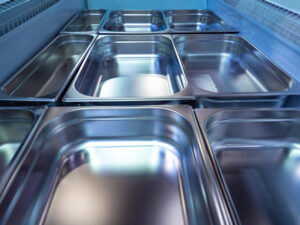
Is all stainless steel food grade? Certainly, stainless steel is a material of choice for various uses and applications in the food and beverage industry. From cutlery and countertops to walk-in refrigerators and transportation tankers, stainless steel meets specific requirements and standards deemed safe for food contact, processing, preparation, and storage. Nonetheless, though there are many grades of stainless steel, only a few in the 300 and 400 series have food-grade properties suitable for use in the food industry. We explain more below.
What Makes Stainless Steel a Safe Choice for Use in the Food Industry?
The inherent properties of stainless steel alloys, including the corrosion resistance that inspired the material’s name, make it ideal for use with liquids and food products. Like other types of steel, stainless steel is an alloy of iron and carbon. Yet, stainless steels also contain a minimum of 10.5% chromium with a carbon content of less than 1.2% to create corrosion-resistant products. Other alloying elements like nickel or molybdenum add to the material’s corrosion-resistant properties, but it is the chromium content that provides a passive, protective layer of chromium oxide on the material’s surface for continuous corrosion resistance. Amazingly, even if the surface is scratched, the material will regenerate itself.
Stainless steel’s corrosion resistance is key in preventing foods or beverages from reacting with any harmful substances that could leach into the food. However, for any material to be considered food grade it must meet certain conditions that are compliant with FDA guidelines. In other words, the material must hold certain mechanical properties compatible with the full range of food handling processes in compliance with FDA regulations. The material itself has to be durable, corrosion resistant, nonabsorbent, and non-porous. It must be of a weight and thickness to withstand repeated washing and rinsing. Food-grade materials must have a smooth finish to easily clean and sanitize the surface. Also, the material must resist chipping, scratching, scoring, pitting, warping, distortion, and decomposition. Finally, the material properties must prevent the migration of harmful substances or the transfer of any odors, tastes, or colors to the food.
Characteristics and Properties of Food-Grade Stainless Steel
The characteristics and properties of food-grade stainless steel check the box on all of these conditions. The strength and durability allow the material to withstand ongoing heavy use and wear from impacts, friction, abrasion, elasticity, and high and low temperature fluctuations. Due to its smooth, non-porous surface, stainless steel also has hygienic properties that greatly reduce the risk of bacterial growth and contamination—viruses, germs, and even stains cannot penetrate the material. Stainless steel’s attractive, shiny appearance is aesthetically pleasing to the eye, and because the material combines elasticity, ductility, and hardness, it can be formed into a variety of products suitable for various food-service applications.
Food-Safe Stainless Steel Grades
As mentioned, though there are many different grades of stainless steel, only a handful in the 300 and 400 series are considered food-grade.
Grade 304 Stainless Steel
The most widely used stainless steel grade for food-related applications is grade 304, an austenitic type of steel known for its high nickel content and ductility.
Also referred to as “18-8,” due to its 18% chromium and 8% nickel content, 304 is regarded for its corrosion resistance to most oxidizing acids, durability, and ease of sanitizing. The material is also easily welded and formed, which makes it well-suited for fabrication into numerous shapes and sizes for the wide range of products and equipment necessary for food processing and production. Grade 304 is used in the manufacture of refrigerators, sinks, stoves, fermentation tanks, dishwashers, and storage tanks.
Grade 316 Stainless Steel
Grade 316 is another austenitic stainless steel used in food production. Known for its higher corrosion-resistant properties due to its 16-18% chromium, 10-14% nickel, and 2-3% molybdenum content, 316 is a good choice for food products vulnerable to saline and chloride solutions, i.e., those with high salt or acidic content. It’s also used where cleaning is constant and required frequently, such as in meat processing plants.
400 Series Stainless Steel
The 400 series are ferritic stainless steels also used in food processing applications. Ferritic alloys are magnetic, with corrosion-cracking-resistant properties and strong resistance to milder organic and nitric acids. Grade 420 manufactures slicer blades, knives, spoons, and forks. Grade 430 steel is commonly used in vegetable processing plants for less corrosive-resistant applications like countertops, tables, and food buffer lines. Its lower nickel content makes it less resistant to corrosion but makes grade 430 less expensive and a lower-cost alternative to the 300-series grades for similar applications.
Contact the Experts at Atlantic Stainless
Food-grade stainless steels are designed to meet strict regulatory and safety standards that are expected for the array of tools, containers, and equipment used in the production, processing, and storage of food and food products. Regarding fabricating equipment used in the food industry, Atlantic Stainless offers high-quality food-grade stainless steel in various finishes, forms, and sizes to meet your production needs. To learn about what stainless steel options we have available in the food industry, please contact us today.

